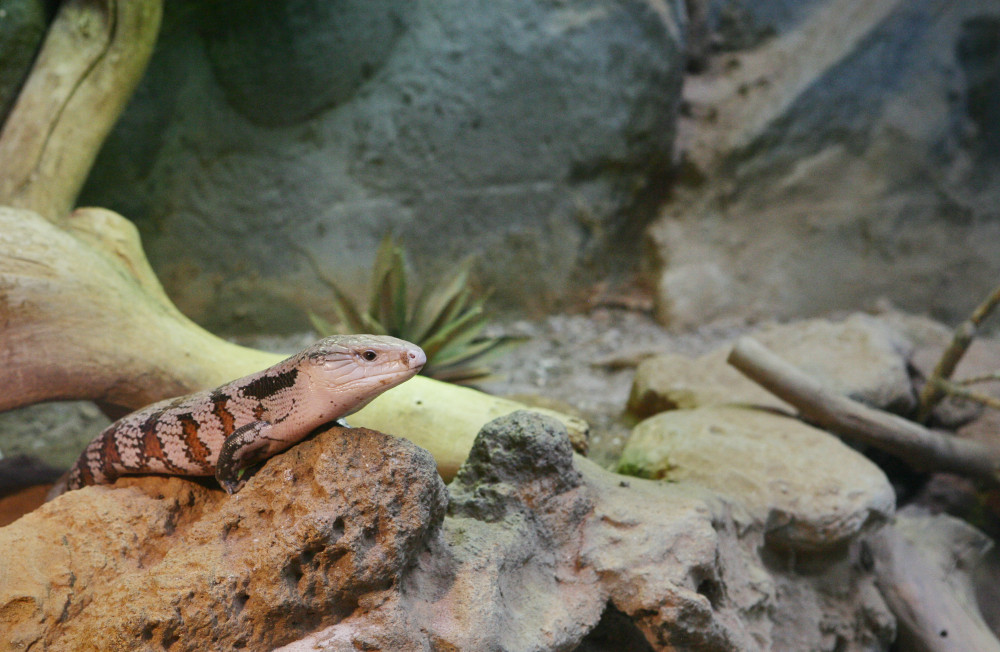How should I care for my blue tongue skink?

The most common reptile species kept as pets are typically medium-sized, non-threatened, captive-bred, and easily obtained. The Eastern Blue Tongue skink (Tiliqua scincoides scincoides) fits this description perfectly, making it a popular pet around the world.
General information
Common name: Eastern Blue Tongue skink
Scientific name: Tiliqua scincoides scincoides
Natural habitat: Blue-tongues can be found throughout eastern and northern Australia where they occupy a wide variety of habitats from temperate lowland grasslands, dry sclerophyll forest, semi-arid grassland and woodland, and coastal plains. They will shelter among large objects on the ground such as logs or rocks or among leaf litter. They are common in suburbia, and many people are proud of ‘their’ blue-tongue in their back yard.
Wild diet: They are a ‘hunter predator,’ an opportunistic omnivore eating a wide variety of plants, fruits, insects, snails, and beetles. One of their favourite foods is snails which, using their strong jaw muscles, they simply crush, chew, and swallow.
Appearance: Eastern blue-tongues have a long, heavyset body, small but strong limbs, and a triangular head. They have an indistinct banded pattern on their back and side, with dark brown or black bands on a grey background. Their belly is a pale grey colour. They weigh approximately 1 kilogram and can grow to 60 centimetres in length. Their skin is smooth covered with scales that overlap and have small bone plates within each scale. They have a deep blue tongue that flicks out frequently.
As a skink, they can use autotomy – a voluntary dropping of the tail – to distract a predator. The tail does grow back, but as a deformed cartilaginous stump or spike.
Behaviour: They are not social animals and can be very territorial towards other Blue Tongues. However, they show very little aggression to other animals and are said to be docile and shy. These skinks are diurnal (most active during the day) and, after basking in the morning to warm up, they will set off in search of food. Once they have eaten, they return to the safety of a large rock or hollow log. Their short legs make climbing very difficult for them.
Fun Fact
Did you know that Blue Tongue skinks give birth to live young, rather than laying eggs?
Keeping a blue-tongue skink
Even though blue-tongue skinks are a common species, you should carefully consider whether a blue-tongue skink is the right pet for you. For information on what to think about before making that decision, please see this article. You also must have a licence to keep them. There are a wide range of sources from where you can obtain a blue-tongue skink, but you must not take them from the wild.
The captive bred skinks are often different in colour from their wild cousins.
Eastern blue-tongue skinks are known to be territorial, which means that keeping multiple ‘blueys’ in the same enclosure can lead to fighting and serious (sometimes even fatal) injuries. So, it’s best to keep only one per enclosure.
Life expectancy for blue-tongue skinks in captivity is 15-20 years. It is often best to acquire an adult or a juvenile who is more than 3–6 months of age. By that time, they should be established, feeding regularly, and demonstrating robust growth. However, adult Blue-tongues adapt to a new environment and owner with minimal difficulty.
Ecdysis (shedding) in Blue Tongue skinks occurs in multiple pieces; shedding frequency depends on growth rate. Watch for retained shed, especially around the digits and tail tip.
Enclosure
- Size: As they are a terrestrial reptile (they live on the ground), the enclosure should be long, rather than tall. An appropriate enclosure for an adult blue-tongue skink could measure 1.2–1.8m long, 0.6m wide, and 0.6–0.9m high.
- Substrate: Blue-tongue skinks are healthiest and happiest when they are housed on a substrate (a.k.a. “bedding”) that imitates the conditions of their natural habitat – i.e., soil (sandy to clay based) or bark.
- Faeces and urates should be removed daily, and contaminated substrate should be scooped out and replaced.
- Substrate should be completely replaced once every 2-3 weeks.
- Although they cannot climb, providing some large flat basking rocks will be appreciated.
- A shelter should be provided but be careful with providing too many plants, as they may raise the humidity too high for this open grasslands species.
Heating and lighting
- Eastern blue-tongue skinks have a preferred body temperature in the low thirties. To reach this, they will need a thermal gradient of 27°C to 42°C (meaning that there should be gradient in the temperature between the ends of their enclosure, so they can choose what temperature they want to be at to help regulate their body temperature).
- As they are diurnal (active during the day), they will need at least 12 hours of light daily.
- They are very reliant on ultraviolet light for the health of their bones, needing either an artificial light source or 4-6 hours of unfiltered sunlight each week.
Humidity
Eastern blue tongue skinks should have an average ambient humidity of 40-60%, as measured by a digital probe hygrometer with the probe placed on the ground on the cool side of the enclosure. Humidity levels that are consistently higher or lower than this range can make your pet unwell.
Diet
Blue Tongues can be fed a balance of:
- Insects (crickets, cockroaches, mealworms), snails, slugs or earthworms. Insects should be ‘gut loaded’ and dusted with calcium powder immediately before been fed to your skink. These should make up 70% of a less than 1 year old skink’s diet, but only 50% of an adult’s.
Note: there are potential welfare and ethical considerations with the feeding of live insects to reptiles to think about; for more information, see this article.
- A mix of green and red vegetables (spinach, coloured lettuce, tomato, red or green peppers, mushrooms or rose petals) with a multivitamin powder sprinkled on the vegetables every two weeks.
- Raw or boiled eggs occasionally (once every 2-3 weeks)
- Fruits such as apple, banana, pear, fig, melon, plum, kiwi fruit, raisins, or strawberries, depending on what is in season.
Their food is best offered to blue-tongues in the late morning through to midday, after they have had time to bask and have become active. Food can be left in the enclosure until the blue-tongue has finished eating but should then be removed.
The frequency of feeding depends on the age of your skink:
- Feed babies (up to 3 months) daily.
- Feed juveniles (3-8 months) 3 times weekly.
- Feed subadults and adults (8+ months) 1-2 times weekly
Bibliography
Turner G (2001) Keeping Blue-tongue Lizards. Australian Birdkeeper Publications
Healey M (2023) Blue Tongue Skink Care Guide in ReptiFiles. Accessed 22 Jun 2023
Doneley B (2017) Taxonomy and Introduction to Common Species. In: Doneley B, Johnson R, Monks D, Carmel B (eds) Reptile medicine and surgery in clinical practice. Wiley-Blackwell, pp 1–14
RSPCA Australia believes that captive-bred wild animals should not be kept in a home environment or for companion purposes unless the species has been clearly identified as being suitable for this purpose. It is important that animals living in a home environment can live a good life. This means providing for their physical health and ensuring opportunities to fully express their individual interests and experience good welfare. Inadequate care and husbandry are reported to contribute to common and serious welfare compromises in many captive wild animals living in home environments. For more information see our policy.
The reality is, however, that captive-bred wild animals are kept in home environments despite sometimes not meeting these criteria (e.g., some reptile and bird species). Because of this, the RSPCA has produced these articles on the care and welfare of a variety of commonly kept captive-bred wild animals. The aim is to help people better understand their animals as individuals and provide them with care that keeps them healthy and provides opportunities for positive mental experiences as much as possible in captivity.
Wild animals must not be taken from the wild to be kept as companion animals (pets).
Was this article helpful?
This work is licensed under a Creative Commons Attribution-NonCommercial-NoDerivatives 4.0 International License.



